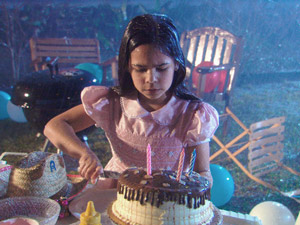Around the year 1919, Soviet director and film theoretician Lev Kuleshov began a series of cinematic experiments in which he projected two successive unrelated images, then measured the response of his audience.

Teresa Hubbard and Alexander Birchler, Eight, 2001 ...High Definition Video with sound transferred to DVD 3 minute, ...35 second loop
His findings revealed an overwhelming instinct on the part of his audience to create concrete relationships between the two images, regardless of their commonalities or differences. Kuleshov concluded that viewers will create a cohesive narrative between two unrelated images based on our desire to find meaning in a linear sequence of cause and effect.
Artists Teresa Hubbard and Alexander Birchler present us with two separate works, Eight, a large scale video installation, and County Line Road, a grouping of four large photographs, which effectively dismantle our comfort zone of narrative assumptions. Within the visually and structurally complex work of Hubbard and Birchler, A+B does not necessarily equal C.
County Line Road is comprised of four large-scale photographs with the dimensions of intimately scaled movie screens. Two of the images show us differing angles of a woman sitting behind the wheel of a pickup truck. There is a cut above her left eye, and a woven plastic bag in the seat beside her. A third image describes the interior of an immaculate, but modest kitchen. Everything seems to be in its proper and expected place: family snapshots on the fridge, dried macaroni in glass jars on the counter, a rag rug on the floor. The fourth image shows us the aftermath of the very same truck crashing through the side of a mobile home into the very same kitchen. Everything in the once-ordered kitchen has been disrupted. The refrigerator lays open on its side, the clock (reading the exact same time as in the pre-crash kitchen) is askew, macaroni and dried beans litter the hood of the pickup. The woman is mysteriously missing from the scene of the accident, in her place sits the woven bag.
Although the four images alternate between order and disorder, calm and chaos, they are all curiously quiet. In all four images the “action” or pivotal event seems to be narrowly avoided, casting doubt onto the existence of the missing event at all. What are we seeing? What has taken place? Has anything actually taken place?
In Michael Cunningham’s book The Hours, he describes the musing of a woman contemplating the possibility of suicide, “…she is glad to know (for some reason she suddenly knows) that it is possible to stop living. There is comfort in facing the full range of options; in considering all of your choices, fearlessly and without guile.”
County Line Road seems quite possibly to be a series of images about considering one’s options; an exploration of the interior mental flip-flopping which so easily transcends logical spatial and temporal relationships. This however is not a definitive explanation of the piece. As with Kuleshov’s experiments, County Line Road seems to rely at least partially on the subjective perceptual variable provided by the viewer. A + B might equal C, but in this case, they very possibly equal D, E and F as well.

Teresa Hubbard and Alexander Birchler, ...County Line Road– Interior with Pickup Truck, Location Single Wide, ...2002, Light jet print on Fuji Crystal paper, 36 x 64 inches
In Eight, an exquisitely composed large-scale video, the artists achieve a similar sense of narrative continuity/discontinuity through the use of a filmic technique most famously employed by Alfred Hitchcock in the movie Rope. By using one continuous camera shot (interrupted only once to cut to a close-up of the little girl), Eight moves seamlessly between the warm interior of a house and the stormy remains of a rained out birthday party. As with County Line Road, the narrative revolves around an individual’s (in this case an eight -year old girl’s) psychological and physical movements between two polarities.
The composed domestic interior contrasts sharply with the exterior remains of the washed-out party. Darkness, torrential rain, and pasty chips floating in plates flattened with rainwater give way to the warm lights and tasteful monochromes of the rooms within the house. But the steady, continuous movement of the camera creates a world in which these two extremes bleed effortlessly together, creating the multifarious backdrop for a young girl determined to enjoy her party, regardless of the obvious imperfections of the conditions.
In Eight as well as County Line Road, Hubbard and Birchler construct a complex and flexible narrative landscape that disallows for any one definitive explanation, but instead quietly insists on a multitude of contradicting realities. It therefore seems likely that the critical “event” within the work does not exist between the images themselves, as much as between the images and their audience. As with much of Hubbard and Birchler’s work, these pieces move seamlessly between the interior and exterior, the real and the imaginary, all the while presenting something that is beautiful as well as challenging.
Images courtesy of the artists and ArtPace.
Joey Fauerso is an arist, member of the Perla publishing collective, and co-director of the Bower Gallery along with Michael Velliquet and Leslee Fraser. She lives in San Antonio.



